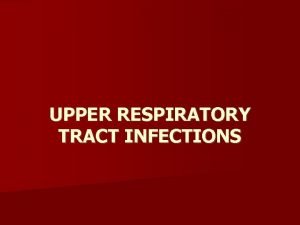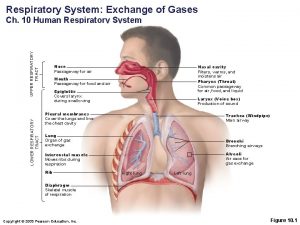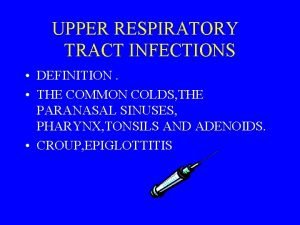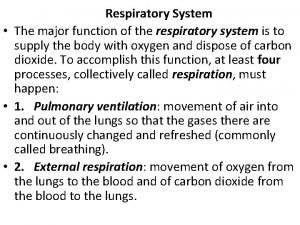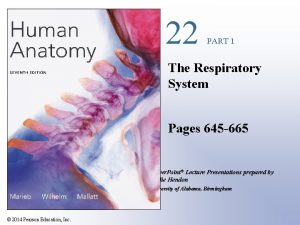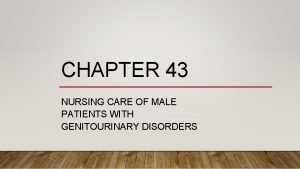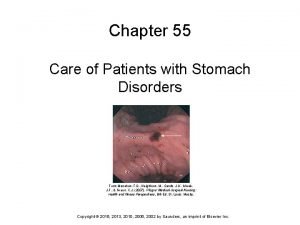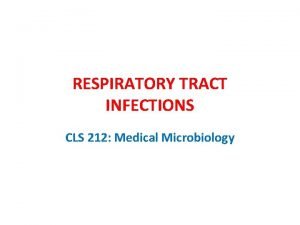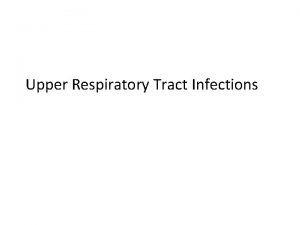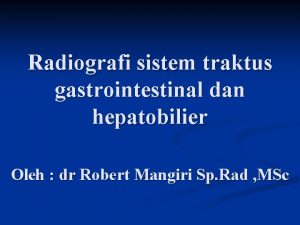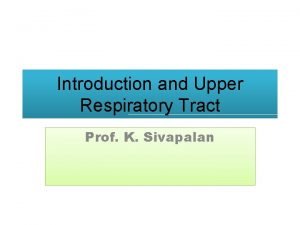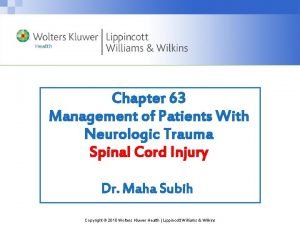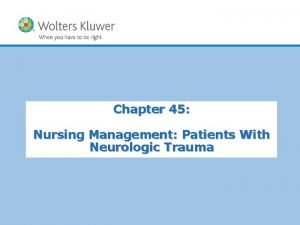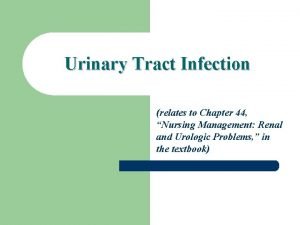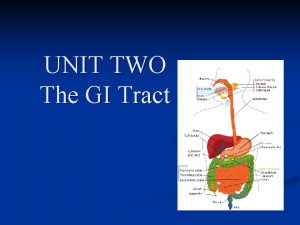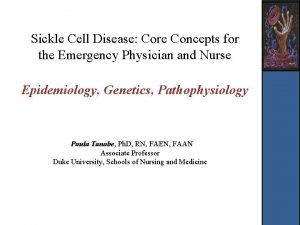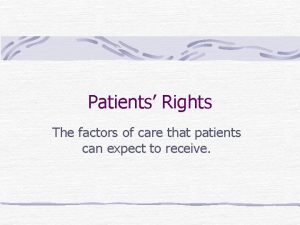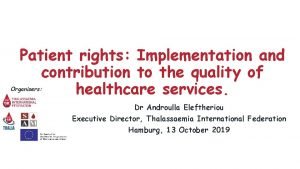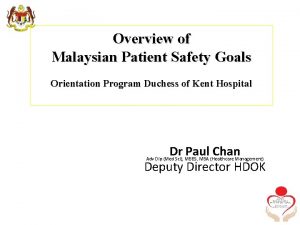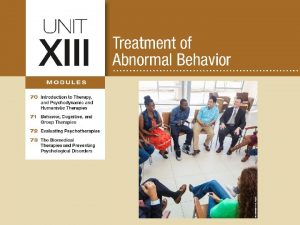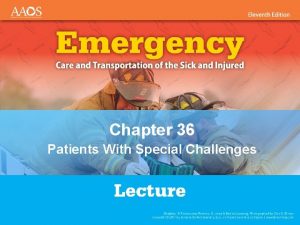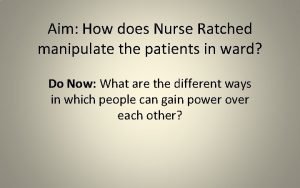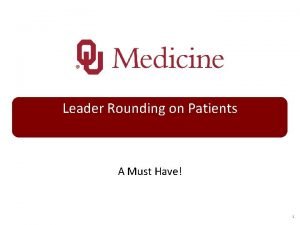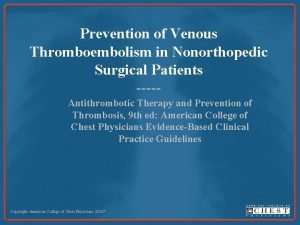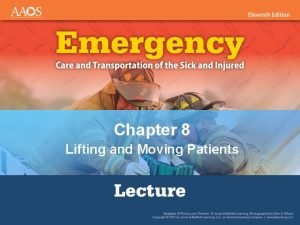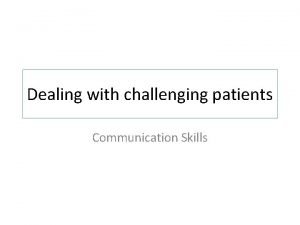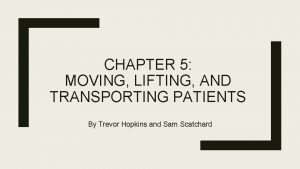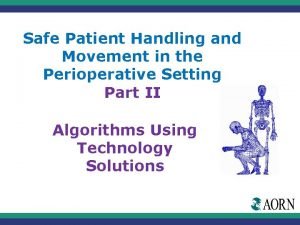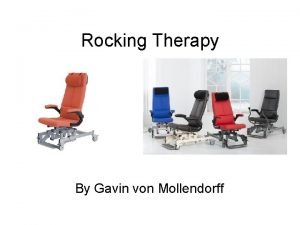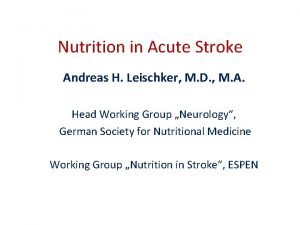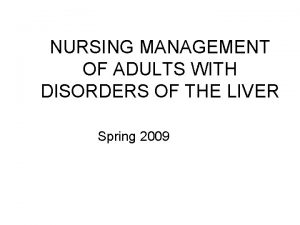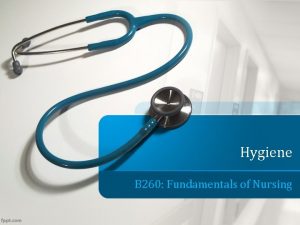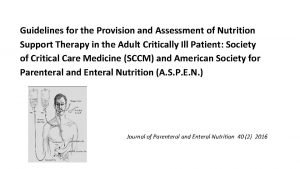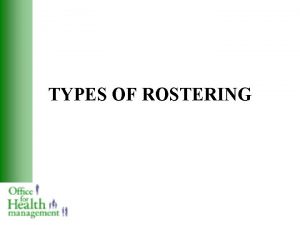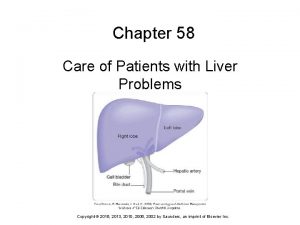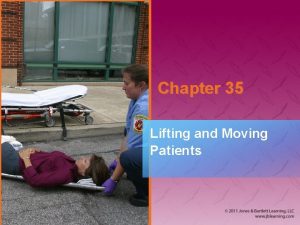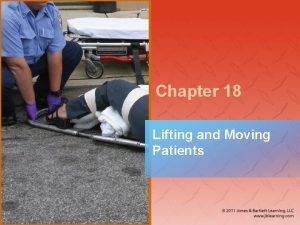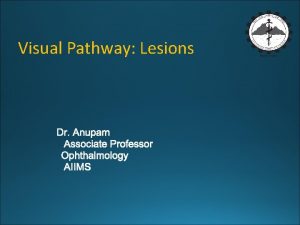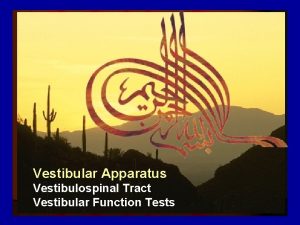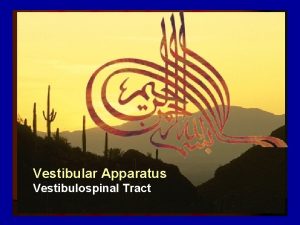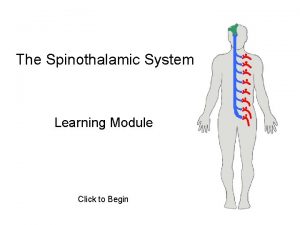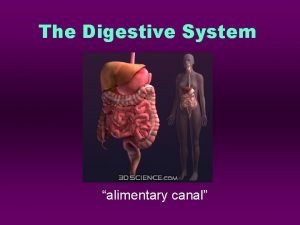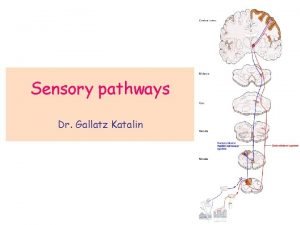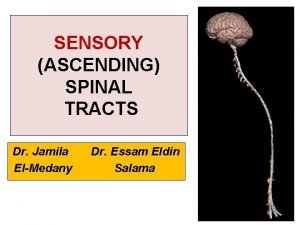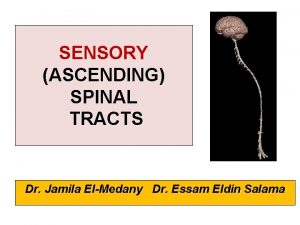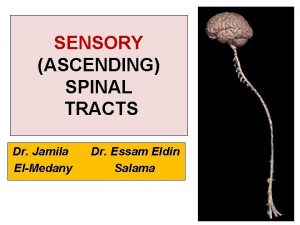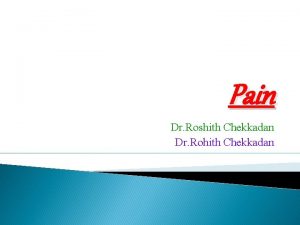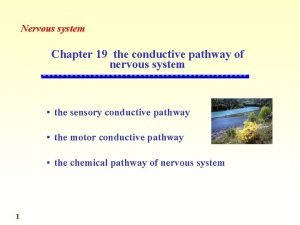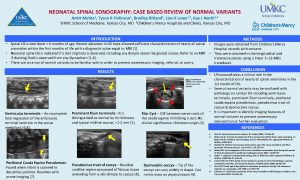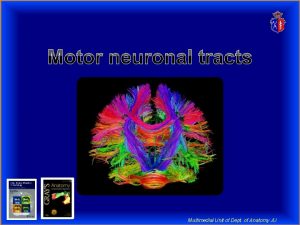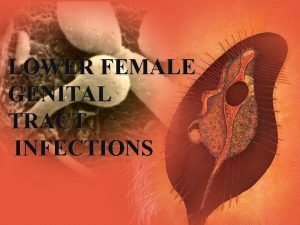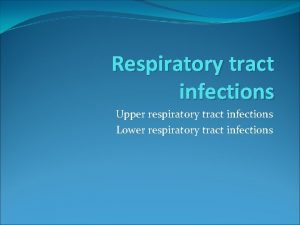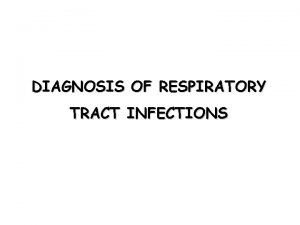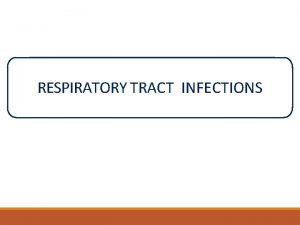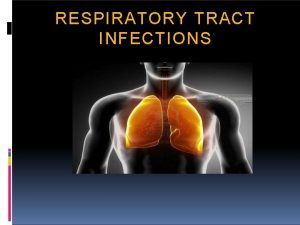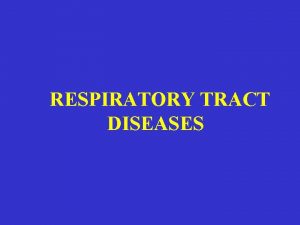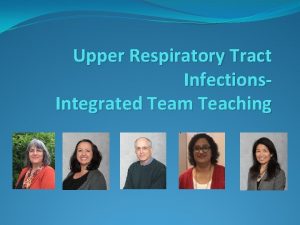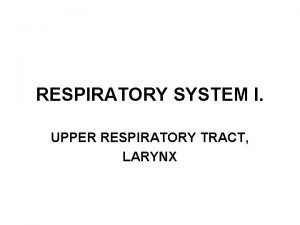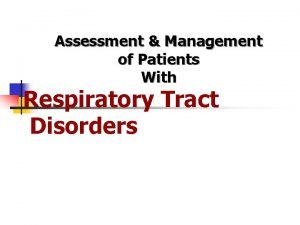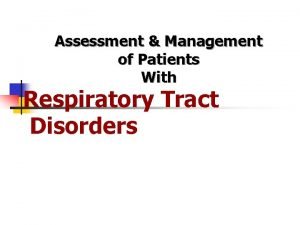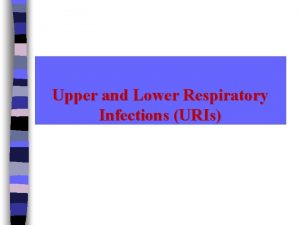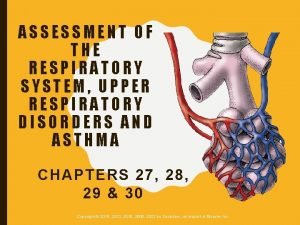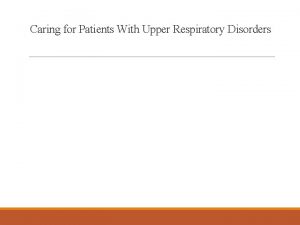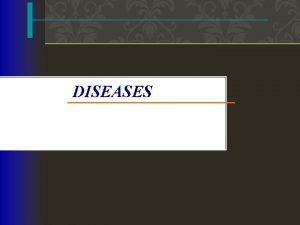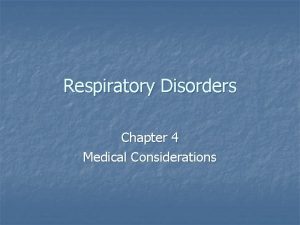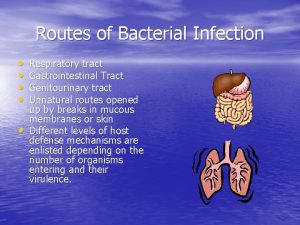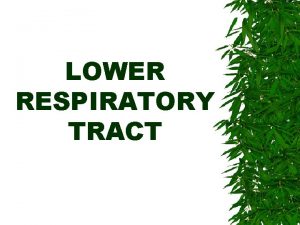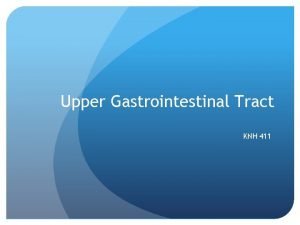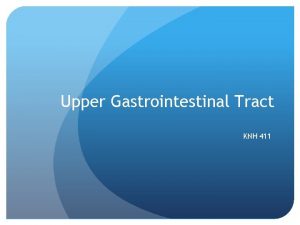Management of Patients With Upper Respiratory Tract Disorders




























































































- Slides: 92

Management of Patients With Upper Respiratory Tract Disorders Copyright © 2010 Wolters Kluwer Health | Lippincott Williams & Wilkins

Nursing Care of Patients with Upper Airway Disorders • Upper airway disorders may be minor, treated outside health care setting – Or may be severe, life threatening • Require good assessment skills, understanding of variety of disorders that affect upper airway, impact those disorders may have on patient • Patient teaching is important aspect of care Copyright © 2010 Wolters Kluwer Health | Lippincott Williams & Wilkins

Specific Disorders • Infections • Rhinitis: is a medical term for irritation and inflammation of the mucous membrane inside the nose • Sinusitis: acute, chronic is inflammation of the sinuses resulting in symptoms include thick nasal mucus, a plugged nose, and pain in the face. Other signs and symptoms may include fever, headaches, poor sense of smell, sore throat, and cough Copyright © 2010 Wolters Kluwer Health | Lippincott Williams & Wilkins

• Pharyngitis: acute, chronic is caused by swelling in the back of the throat (pharynx) between the tonsils and the voice box (larynx). Most sore throats are caused by colds, the flu, coxsackie virus or mono (mononucleosis). Bacteria that can cause pharyngitis in some cases: Strep throat is caused by group A streptococcus • Tonsillitis, Symptoms include a sore throat, swollen tonsils, and fever. This condition is contagious and can be caused by a variety of common viruses and bacteria, such as Streptococcal bacteria • Adenoiditis is an inflammation of the adenoids caused by infection. Adenoids are masses of lymphatic tissue that help the body fight infection. Adenoids are found in the throat, also called the pharynx, just behind the nose. Along with the tonsils, adenoids are the first line of defense against bacteria and viruses. Copyright © 2010 Wolters Kluwer Health | Lippincott Williams & Wilkins

• Peritonisillar abscess: is a bacterial infection that usually begins as a complication of untreated strep throat or tonsillitis. It generally involves a pus-filled pocket that forms near one of your tonsils. Peritonsillar abscesses are most common in children, adolescents, and young adults • Laryngitis: occurs when your voice box or vocal cords become inflamed from overuse, irritation, or infection. Laryngitis can be acute (short-term), lasting less than three weeks. Or it can be chronic (long-term), lasting more than three weeks. Many conditions can cause the inflammation that results in laryngitis Copyright © 2010 Wolters Kluwer Health | Lippincott Williams & Wilkins

Rhinitis and Sinusitis Copyright © 2010 Wolters Kluwer Health | Lippincott Williams & Wilkins

Pharyngitis Copyright © 2010 Wolters Kluwer Health | Lippincott Williams & Wilkins

Common Cold • Rhinitis • Viral rhinitis Pathophysiology • Rhinovirus • “Infection with acute inflammation of the mucous membrane of the nasal cavity” Copyright © 2010 Wolters Kluwer Health | Lippincott Williams & Wilkins

Common Cold Etiology • Airborne • Peak Times – Sept, Jan & April • Duration – 5 -14 days Copyright © 2010 Wolters Kluwer Health | Lippincott Williams & Wilkins

Common Cold Clinical Manifestations • Nasal congestion • Runny nose • Sore throat • Sneezing • Malaise • Afibrile • H/A • Cough Copyright © 2010 Wolters Kluwer Health | Lippincott Williams & Wilkins

Common Cold Dx exams & Procedures • S&S • Culture Copyright © 2010 Wolters Kluwer Health | Lippincott Williams & Wilkins

Common Cold Tx methodology • Focus – relief • Tx not shorten • Fluids • Warm, moist air • Medications – OTC Copyright © 2010 Wolters Kluwer Health | Lippincott Williams & Wilkins

Common Cold Medications • Antihistamines – Action • H 1 blockers inhibits action • Take early • Allergies Copyright © 2010 Wolters Kluwer Health | Lippincott Williams & Wilkins

Common Cold Medications • Antihistamines – Rx effect • Prevents salivary, gastric, lacrimal and bronchial secretions • Relieves • Sneezing • Rhinorrhea • Nasal congestion Copyright © 2010 Wolters Kluwer Health | Lippincott Williams & Wilkins

Common Cold Medications • Antihistamines – Side effects • Drowsiness • Drying – Examples • Allergra • Claritin • Benadryl Copyright © 2010 Wolters Kluwer Health | Lippincott Williams & Wilkins

Common Cold Medications • Decongestants – Rx Actions • Shrink engorged nasal mucus membranes – Side Effects • Rebound congestion • Insomnia Copyright © 2010 Wolters Kluwer Health | Lippincott Williams & Wilkins

Common Cold Medications • Decongestants – Examples • Sudafed • Vicks inhaler • Afrin Copyright © 2010 Wolters Kluwer Health | Lippincott Williams & Wilkins

Common Cold Medications • Anti-tussives – Rx Action – Side effects – Example Copyright © 2010 Wolters Kluwer Health | Lippincott Williams & Wilkins

Common Cold Medications • Analgesics – Tylenol (Acetomenaphen) – Motrin (ibuprofen) • NSAID – Non-narcotic Copyright © 2010 Wolters Kluwer Health | Lippincott Williams & Wilkins

Common Cold Medications • Vitamin C Copyright © 2010 Wolters Kluwer Health | Lippincott Williams & Wilkins

Common Cold Medications • Antibiotics – Prophylactic – Examples • Sulfonamides • Penicillins • Cephalosporins • Tetrcyclines • Aminglycosides • Quinolones • Macrolides • Vancomycin Copyright © 2010 Wolters Kluwer Health | Lippincott Williams & Wilkins

Common Cold Medications • Anti-biotic – Side-effects • N/V • Yeast infections • Resistance Copyright © 2010 Wolters Kluwer Health | Lippincott Williams & Wilkins

Common Cold Nrs Managements • See MD > 2 wks • Prevention How do you prevent the cold from getting you? – Hand wash – Cover mouth – Throw away tissue – Avoid crowds – Vaccine – Eat right – Sleep – Stress – Exercise – Smoking – Allergens – Animals – Carpet Copyright © 2010 Wolters Kluwer Health | Lippincott Williams & Wilkins

Common Cold Complications • Bronchitis • Pneumonia • Conjunctivitis Copyright © 2010 Wolters Kluwer Health | Lippincott Williams & Wilkins

Sinusitis: sinus infection Pathophysiology • Inflammation of the mucus membrane of one or more sinuses • Blocks the egress of sinuses Copyright © 2010 Wolters Kluwer Health | Lippincott Williams & Wilkins

Sinusitis: sinus infection Etiology • Bacterial or viral? – #1 bacterial • Tooth abscess • Allergies • Structural abnormalities Copyright © 2010 Wolters Kluwer Health | Lippincott Williams & Wilkins

Sinusitis: sinus infection Clinical manifestations • Ethmoid sinusitis • Pain – Maxillary • Over cheek and upper teeth – Ethmoid • Btw & behind eyes – Frontal • Forehead Copyright © 2010 Wolters Kluwer Health | Lippincott Williams & Wilkins

Sinusitis: sinus infection Clinical manifestations • Anosnia • H/A • Fever? • Fatigue? • Foul breath? Copyright © 2010 Wolters Kluwer Health | Lippincott Williams & Wilkins

Sinusitis: sinus infection Dx • S&S • X-ray, CT, MRI • C & S Copyright © 2010 Wolters Kluwer Health | Lippincott Williams & Wilkins

Sinusitis: sinus infection Med Tx • Antibiotics • Analgesics – No aspirin • Nasal decongestants • Mucolytic agents • Surgery Copyright © 2010 Wolters Kluwer Health | Lippincott Williams & Wilkins

Sinusitis: sinus infection NRS interventions – Rest • Fluids – • Activity • Moist hot-packs h • Position – HOB h • Cleaning techniques – Irrigate nose • Copyright © 2010 Wolters Kluwer Health | Lippincott Williams & Wilkins

Sinusitis: sinus infection Prevention • Avoid contributing factors: – Cold – Smoking – Fatigue – URI • Dentist Copyright © 2010 Wolters Kluwer Health | Lippincott Williams & Wilkins

Sinusitis: sinus infection Complications • Osteomylitis • Cellulitis of the orbit • Abscess • Meningitis Copyright © 2010 Wolters Kluwer Health | Lippincott Williams & Wilkins

Sinusitis: sinus infection • Surgery • Post-op care – Position – Oral care – Packing x 48 hrs • Side lying – No blowing • semi-fowler – Tarry stools – Ice – Avoid constipation – Monitor for • Bleeding • i visual acuity • Pain • S&S of infection Copyright © 2010 Wolters Kluwer Health | Lippincott Williams & Wilkins

Acute Pharyngitis Pathophysiology • AKA: sore throat, strep throat • Inflammation of the throat Copyright © 2010 Wolters Kluwer Health | Lippincott Williams & Wilkins

Acute Pharyngitis Etiology • 70% – Viral • Bacterial – Streptococcus Copyright © 2010 Wolters Kluwer Health | Lippincott Williams & Wilkins

Acute Pharyngitis Clinical manifestations • Lymphnoids • Sore throat – Malaise* • Febrile – Hoarseness* • Dysphagia • Exudate – Cough* – Rhinitis* Copyright © 2010 Wolters Kluwer Health | Lippincott Williams & Wilkins

Acute Pharyngitis Dx exams • Throat culture • Rapid screening Copyright © 2010 Wolters Kluwer Health | Lippincott Williams & Wilkins

Acute Pharyngitis - Tx • Viral – Supportive – Like a cold • Bacterial – Antibiotics – Diet • Liquid/soft – Analgesics • Tylenol Copyright © 2010 Wolters Kluwer Health | Lippincott Williams & Wilkins

Acute Pharyngitis - Nrs • Rest • Fluids • Rashes? – Communicable disease • Warm saline gargles – h • Ice collar • Oral care – Temp 105 -110 F • Diet – Liquid Copyright © 2010 Wolters Kluwer Health | Lippincott Williams & Wilkins

Acute Pharyngitis Complications • Rheumatic Fever • Sinusitis – 2 -3 wk /p subsides • Ottis media – Heart damage • Peritonsillar abscess • Mitral valve damage • Scarlet fever Copyright © 2010 Wolters Kluwer Health | Lippincott Williams & Wilkins

Tonsillitis & Adenoiditis Pathophysiology • Tonsils – Location • Oropharynx – Lymph tissue • Adenoids – Location • Nasopharynx Copyright © 2010 Wolters Kluwer Health | Lippincott Williams & Wilkins

Tonsillitis & Adenoiditis Etiology • Streptococcus • Low resistance • Children Copyright © 2010 Wolters Kluwer Health | Lippincott Williams & Wilkins

Tonsillitis & Adenoiditis – S&S • Sore throat • Febrile & chills • Snoring • Dysphagia • Adenoids – Mouth breathing • Duration – 1 -2 wks Copyright © 2010 Wolters Kluwer Health | Lippincott Williams & Wilkins

Tonsillitis & Adenoiditis - Dx Dx • Mono • Visualize • C&S Copyright © 2010 Wolters Kluwer Health | Lippincott Williams & Wilkins

Tonsillitis & Adenoiditis Post-op care – Restlessness • Hemorrhaging – Tarry stool – Coffee ground emeses – h swallowing – Bright red emeses – Pulse • h – Temp • h Copyright © 2010 Wolters Kluwer Health | Lippincott Williams & Wilkins

Tonsillitis & Adenoiditis Post-op • Position – Prone/side lying until… • Pain control – Ice collar – Acetaminophen • Not aspirin • Gag returns – Semi-fowler’s Copyright © 2010 Wolters Kluwer Health | Lippincott Williams & Wilkins

Tonsillitis & Adenoiditis – Milk products Post-op • i • Diet – Ice cold fluids – Adv. To normal ASAP • 2 -3 days – Avoid • Spicy • Hot • Acidic • Rough Copyright © 2010 Wolters Kluwer Health | Lippincott Williams & Wilkins

Tonsillitis & Adenoiditis • Post-op • Pt education – Expect black tarry stools – Normal activity ASAP – S&S of hemorrhaging – Mouthwash good – Avoid • Coughing • Sneezing • Vigorous nose blow • Vigorous gargling • Rough foods Copyright © 2010 Wolters Kluwer Health | Lippincott Williams & Wilkins

Peritonsillar Abscess Pathophysiology • Pus & blood filled sacs on tonsil Etiology • Complication of strep throat Copyright © 2010 Wolters Kluwer Health | Lippincott Williams & Wilkins

Peritonsillar Abscess S&S • Pain – Local – Radiates ear • Dysphagia – drooling • Dysphasia • Fever Copyright © 2010 Wolters Kluwer Health | Lippincott Williams & Wilkins

Peritonsillar Abscess Tx • Ice collar • Antibiotics • No smoking • Incision & drain – Lanse • Ventilator? • Warm saline irrigation • Hydrogen peroxide • Analgesics – Topical – Tylenol Copyright © 2010 Wolters Kluwer Health | Lippincott Williams & Wilkins

Laryngitis • Pathophysiology – Inflammation of the mucous membrane lining the larynx – With edema of the vocal cords Copyright © 2010 Wolters Kluwer Health | Lippincott Williams & Wilkins

Laryngitis • Etiology – Viral – Voice abuse – Dust Copyright © 2010 Wolters Kluwer Health | Lippincott Williams & Wilkins

Laryngitis • Risk factors – Airborne irritants – Cold – Resent RTI – Smoking Copyright © 2010 Wolters Kluwer Health | Lippincott Williams & Wilkins

Laryngitis • Clinical manifestations – Aphonia • Voice loss – Hoarseness – Cough? • Severe Copyright © 2010 Wolters Kluwer Health | Lippincott Williams & Wilkins

Laryngitis • Treatment – Voice rest – Bed rest – Smoking? • NO! – Humidifier – Fluids? • h – Expectorants Copyright © 2010 Wolters Kluwer Health | Lippincott Williams & Wilkins

Laryngitis • Prevention – Avoid… • Irritants • Cold • Voice strain • Smoking Copyright © 2010 Wolters Kluwer Health | Lippincott Williams & Wilkins

Question • Tell whether the following statement is true or false: • Acute pharyngitis of a bacterial nature is most commonly caused by group A, beta-hemolytic streptococci. Copyright © 2010 Wolters Kluwer Health | Lippincott Williams & Wilkins

Answer • True. • Rationale: Acute pharyngitis of a bacterial nature is most commonly caused by group A, beta-hemolytic streptococci. Copyright © 2010 Wolters Kluwer Health | Lippincott Williams & Wilkins

Potential Complications • Sepsis • Meningitis • Peritonsillar abscess • Otitis media • Sinusitis Copyright © 2010 Wolters Kluwer Health | Lippincott Williams & Wilkins

Nursing Process: Care of Patients with Upper Respiratory Infections Assessment • Health history • Signs and symptoms: headache, cough, hoarseness, fever, stuffiness, generalized discomfort and fatigue • Allergies • Inspection of nose, neck, throat – Include palpation of lymph nodes Copyright © 2010 Wolters Kluwer Health | Lippincott Williams & Wilkins

Question • What should the nurse palpate when assessing for an upper respiratory tract infection? A. Neck lymph nodes B. Nasal mucosa C. Tracheal mucosa D. All of the above Copyright © 2010 Wolters Kluwer Health | Lippincott Williams & Wilkins

Answer • A. Neck lymph nodes • Rationale: The nurse should palpate the neck lymph nodes along with the trachea and the frontal and maxillary sinuses when assessing for an upper respiratory tract infection. The nurse should inspect the nasal and tracheal mucosa when assessing for an upper respiratory tract infection. Copyright © 2010 Wolters Kluwer Health | Lippincott Williams & Wilkins

Nursing Process: Care of Patients with Upper Respiratory Infections - Diagnosis • Ineffective airway clearance • Acute pain • Impaired verbal communication • Deficient fluid volume • Deficit of knowledge related to prevention, treatment, surgical procedure, postoperative care Copyright © 2010 Wolters Kluwer Health | Lippincott Williams & Wilkins

Nursing Process: Care of Patients with Upper Respiratory Infections - Planning • Maintenance of patent airway • Relief of pain • Maintenance of effective communication • Normal hydration • Knowledge to how to prevent upper airway infections • Absence of complications Copyright © 2010 Wolters Kluwer Health | Lippincott Williams & Wilkins

Interventions • Interventions to maintain patent airway • Promote comfort – Analgesics – Gargles for sore throat – Use of hot packs for sinus congestion or ice collar to reduce swelling, bleeding post tonsillectomy and adenoidectomy Copyright © 2010 Wolters Kluwer Health | Lippincott Williams & Wilkins

Interventions (cont’d) • Rest • Refrain from speaking, use alternative communication • Encourage liquids; 2 to 3 L a day, appropriate foods Copyright © 2010 Wolters Kluwer Health | Lippincott Williams & Wilkins

Patient Education • Prevention of upper airway infections • Emphasize frequent hand washing • When to contact health care provider • Need to complete antibiotic treatment regimen • Annual influenza vaccine for those at risk Copyright © 2010 Wolters Kluwer Health | Lippincott Williams & Wilkins

Epistaxis • Hemorrhage from nose • Risk factors • Sites of bleeding – Most common: anterior septum • Can be serious problem resulting is significant blood loss or airway compromise Copyright © 2010 Wolters Kluwer Health | Lippincott Williams & Wilkins

Treatment of Epistaxis • Topical vasoconstrictors – Adrenaline – Cocaine – Phenylephrine • Packing of nasal cavity or balloon catheter Copyright © 2010 Wolters Kluwer Health | Lippincott Williams & Wilkins

Control of Epistaxis Copyright © 2010 Wolters Kluwer Health | Lippincott Williams & Wilkins

Nursing Care of Patients with Epistaxis • Assessment of bleeding • Monitor airway, breathing • Vital signs • Reduce anxiety • Patient teaching – Avoid nasal trauma, nose picking, nose blowing – Air humidification – Pressure on nose to stop bleeding; if bleeding does not stop in 15 minutes, seek medical attention Copyright © 2010 Wolters Kluwer Health | Lippincott Williams & Wilkins

Cancer of the Larynx • Incidence • Risk factors • Categories – Supraglottic: false vocal cords above vocal cords – Glottic: true vocal cords – Subglottic: below vocal cords Copyright © 2010 Wolters Kluwer Health | Lippincott Williams & Wilkins

Symptoms • Hoarseness • Persistent cough • Sore throat or pain, burning in throat • Lump in neck • Later symptoms: dysphagia, dyspnea, unilateral nasal obstruction, persistent hoarseness, persistent ulceration, foul breath • Generalized symptoms: weight loss, debilitation, lymphadenopathy, radiation of pain to ear Copyright © 2010 Wolters Kluwer Health | Lippincott Williams & Wilkins

Question • Tell whether the following statement is true or false: • An early sign of cancer of the larynx in the glottic are is enlarged cervical nodes. Copyright © 2010 Wolters Kluwer Health | Lippincott Williams & Wilkins

Answer • False. • Rationale: An early sign of cancer of the larynx in the glottic are is affected voice sounds, not enlarged cervical nodes. Copyright © 2010 Wolters Kluwer Health | Lippincott Williams & Wilkins

Medical Diagnosis • Diagnosis made by history, physical exam, laryngoscopic exam, biopsy • Tumors staged by TMN classification • CT, MRI, to assess tumor extent and stage, to determine reoccurrence Copyright © 2010 Wolters Kluwer Health | Lippincott Williams & Wilkins

Medical Treatment • Radiation therapy • Chemotherapy • Surgery – Partial laryngectomy – Supraglottic laryngectomy – Hemilaryngectomy – Total laryngectomy Copyright © 2010 Wolters Kluwer Health | Lippincott Williams & Wilkins

Changes in Airflow with Total Laryngectomy Copyright © 2010 Wolters Kluwer Health | Lippincott Williams & Wilkins

Nursing Process: Care of a Patient with a Laryngectomy - Assessment • Health history • Assess history of alcohol abuse • Physical assessment • Nutritional status • Assess literacy, hearing, visual ability; may impact communication • Assess learning needs • Assess patient, family coping, support systems Copyright © 2010 Wolters Kluwer Health | Lippincott Williams & Wilkins

Nursing Process: Care of a Patient with a Laryngectomy - Diagnoses • Deficit knowledge related to surgical procedure, postoperative course • Anxiety, depression • Ineffective airway clearance • Impaired verbal communication • Imbalanced nutrition • Disturbed body image • Self-care deficit Copyright © 2010 Wolters Kluwer Health | Lippincott Williams & Wilkins

Potential Collaborative Problems • Respiratory distress • Hemorrhage • Infections • Wound breakdown • Aspiration Copyright © 2010 Wolters Kluwer Health | Lippincott Williams & Wilkins

Nursing Process: Care of a Patient with a Laryngectomy - Planning • Adequate level of knowledge (patient, family) • Reduction of anxiety • Maintenance of patent airway • Effective means of communication • Attaining optimum hydration, nutrition • Improved body image, self-esteem • Self-care management • Absence of complications Copyright © 2010 Wolters Kluwer Health | Lippincott Williams & Wilkins

Preoperative Teaching • Instruction regarding type of procedure, resultant changes (changes in speech, permanent loss of speech, changes in airway) • Include instruction regarding tubes used postoperatively (drainage tubes, feeding tubes), provide general preoperative teaching to prevent postoperative complications Copyright © 2010 Wolters Kluwer Health | Lippincott Williams & Wilkins

Preoperative Teaching (cont’d) • Include planning for postoperative communication, longterm speech rehabilitation • Utilize collaborative approach • Include physician, speech therapy, dietary, social work, clinical nurse specialist, others as required Copyright © 2010 Wolters Kluwer Health | Lippincott Williams & Wilkins

Anxiety and Depression • Allow asking of questions, provide information • Permit verbalization of feelings • Interventions to reduce anxiety, promote comfort • Reassuring manner • Stay with patient during episodes of anxiety • Relaxation techniques Copyright © 2010 Wolters Kluwer Health | Lippincott Williams & Wilkins

Maintaining a Patent Airway • Semi Fowler’s or high Fowler’s position to decrease edema • Monitor for signs, symptoms of respiratory distress • Tracheostomy or laryngectomy tube assessment, care • Care of stoma • Suctioning • Humidification of air • Patient teaching Copyright © 2010 Wolters Kluwer Health | Lippincott Williams & Wilkins

Communication • Plan communication preoperatively • Immediate postoperative communication – Magic slate – Communication board • Speech rehabilitation Copyright © 2010 Wolters Kluwer Health | Lippincott Williams & Wilkins

TEP Voice Prosthesis Copyright © 2010 Wolters Kluwer Health | Lippincott Williams & Wilkins

• is a device made of medical grade silicone, which is positioned within the “party wall” which is the shared wall between the trachea and the esophagus. The voice prosthesis itself does not produce a voice. The purpose of the prosthesis is to allow air to be delivered from the lungs into the esophagus where it is expelled through the mouth. The passage of air as it travels from the esophagus to the mouth, results in vibration of tissues in the lower pharynx, or throat, producing sound which serves as the new voice for laryngectomy patients. These devices function through the use of a one-way valves The valve serves to open as air flows through, then should close completely when speech is over to ensure food and liquid from the esophagus are not allowed to enter the trachea Copyright © 2010 Wolters Kluwer Health | Lippincott Williams & Wilkins

Potential for Aspiration • Keep HOB elevated during, after tube feedings • Check gastric residual when administering tube feedings • When patient begins oral feeding, maintain upright bed position during, after feedings • Swallowing maneuvers to prevent aspiration • Use of thickened liquids Copyright © 2010 Wolters Kluwer Health | Lippincott Williams & Wilkins
 Upper and lower airway diagram
Upper and lower airway diagram Classification of upper respiratory tract infection
Classification of upper respiratory tract infection Upper and lower respiratory tract
Upper and lower respiratory tract Anatomy of the upper respiratory tract
Anatomy of the upper respiratory tract Rsv sympyoms
Rsv sympyoms Upper rti
Upper rti Upper respiratory tract
Upper respiratory tract Respiratory system nasal cavity
Respiratory system nasal cavity Pyramidal vs extrapyramidal lesions
Pyramidal vs extrapyramidal lesions Dorsal reticulospinal tract
Dorsal reticulospinal tract Nursing diagnosis for undescended testis
Nursing diagnosis for undescended testis Chapter 55 care of patients with stomach disorders
Chapter 55 care of patients with stomach disorders Air passageway
Air passageway Classification of pneumonia
Classification of pneumonia Conclusion of respiratory tract infection
Conclusion of respiratory tract infection Normal flora of respiratory tract
Normal flora of respiratory tract Upper gi tract
Upper gi tract Conducting zone respiratory
Conducting zone respiratory Broncheols
Broncheols Lippincott williams
Lippincott williams Management of patients with neurologic trauma
Management of patients with neurologic trauma Cva
Cva Urised otc
Urised otc Sexually transmitted diseases
Sexually transmitted diseases Who analgesic ladder
Who analgesic ladder Nursing diagnosis for pud
Nursing diagnosis for pud Upper gi bleeding management
Upper gi bleeding management Life expectancy of sickle cell patients
Life expectancy of sickle cell patients Fowler position used for
Fowler position used for Perimylolysis
Perimylolysis Factors of care patients can expect
Factors of care patients can expect Patients rights charter
Patients rights charter Malaysian patient safety goal
Malaysian patient safety goal Nursing care plan for eye surgery
Nursing care plan for eye surgery Nursing diagnosis ocd
Nursing diagnosis ocd Daily intentional nurse leader rounding on patients
Daily intentional nurse leader rounding on patients Dr carlson advises his depressed patients
Dr carlson advises his depressed patients Moving and lifting of the patient
Moving and lifting of the patient Patients with special challenges
Patients with special challenges How does nurse ratched manipulate the patients
How does nurse ratched manipulate the patients Nurses responsibility in admission procedure
Nurses responsibility in admission procedure Moving and handling dementia patients
Moving and handling dementia patients Leader rounding on patients
Leader rounding on patients Ethical issues in treating lgbt patients
Ethical issues in treating lgbt patients Ridge parallelism
Ridge parallelism Prevention of vte in nonorthopedic surgical patients
Prevention of vte in nonorthopedic surgical patients Direct ground lift emt
Direct ground lift emt Dealing with challenging patients
Dealing with challenging patients Fowler position
Fowler position Pico questions
Pico questions Handling patients
Handling patients Rocking chair therapy for dementia patients
Rocking chair therapy for dementia patients Edward oxford
Edward oxford Patient responsibility
Patient responsibility Guideline clinical nutrition in patients with stroke
Guideline clinical nutrition in patients with stroke Diet chart for diabetic patients
Diet chart for diabetic patients Nursing care plan for breast cancer ppt
Nursing care plan for breast cancer ppt Safe staffing ratios: benefiting nurses and patients
Safe staffing ratios: benefiting nurses and patients Hygiene fundamentals of nursing
Hygiene fundamentals of nursing Diet chart for icu patients
Diet chart for icu patients Some patients shout in pain while ______ an injection.
Some patients shout in pain while ______ an injection. Rostering patients
Rostering patients Shampoo caps for bedridden patients
Shampoo caps for bedridden patients Medicare improvements for patients and providers act
Medicare improvements for patients and providers act Food safety for immunocompromised patients
Food safety for immunocompromised patients Chapter 58 care of patients with liver problems
Chapter 58 care of patients with liver problems You may injure your back if you lift
You may injure your back if you lift Straddle slide technique
Straddle slide technique Care map nursing
Care map nursing Tract word list
Tract word list Pie on the floor visual field defect
Pie on the floor visual field defect Vestibular
Vestibular Kinocillia
Kinocillia Syringomyelia
Syringomyelia Quotes the secret life of walter mitty
Quotes the secret life of walter mitty Alimentary canal
Alimentary canal Corticospinal tract pathway
Corticospinal tract pathway Dr gallatz katalin
Dr gallatz katalin Spinocerebellar tract
Spinocerebellar tract Descending tracts
Descending tracts Spinothalamic tract
Spinothalamic tract Spinocerebellar tract
Spinocerebellar tract Pyramidal tract
Pyramidal tract Anterior corticospinal tract
Anterior corticospinal tract Cnidae
Cnidae Archispinothalamic tract
Archispinothalamic tract Pathway of direct light reflex
Pathway of direct light reflex Pseudosinus tract
Pseudosinus tract Projection tract example
Projection tract example Difference between pyramidal and extrapyramidal tract
Difference between pyramidal and extrapyramidal tract Extrapyramidal tract names
Extrapyramidal tract names Cyclic vulvovaginitis
Cyclic vulvovaginitis Gastrointestinal tract
Gastrointestinal tract

